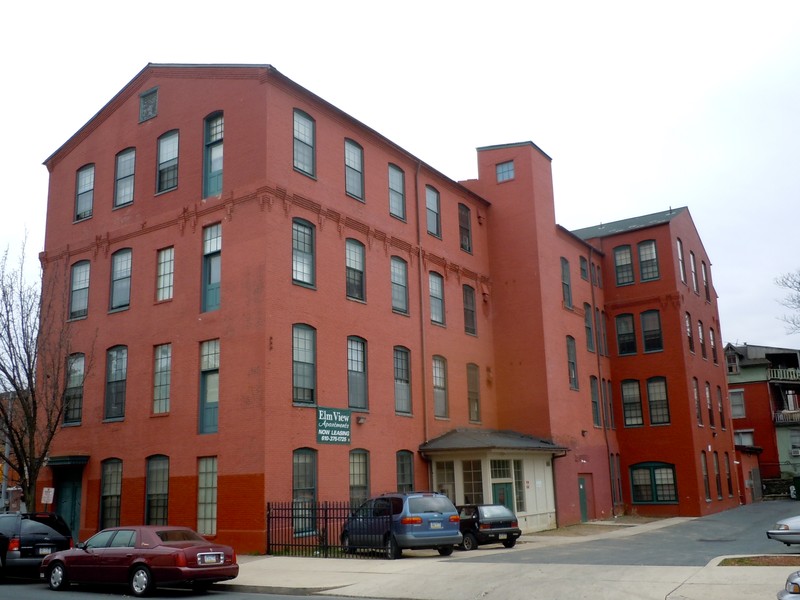Reading Knitting Mills
Introduction
Text-to-speech Audio
Located in the heart of Reading, PA, the Reading Knitting Mills was once a textile factory that was home to a hosiery manufacturing company. The building design begin in April 1891 and the owners, Mr. and Mrs. I.C. Hunnsicker, would officially open doors for business under the name on July 2, 1891. Although other manufacturing companies existed in the nearby surrounding area, the Mills quickly became the top competitor due to its hundreds of employees who were able to turn out high quality hosiery in great quantities. Production numbers report that up to 800 pairs of stockings were made both by hand and machine in just a single day. Today, the building is a historic reminder of that Reading has a rich past of industry that shaped the American Northeast.
Images
The Reading Knitting Mills designed by Levi Focht and constructed by George W. Beard in 1891

Backstory and Context
Text-to-speech Audio
Production was a vital aspect to Reading’s economy throughout the 20th century. There was a brand new way of thinking about technology after the Industrial Revolution, so there were innovation taking place across many industries already. In the case of the city of Reading, textile manufacturing would become a prominent industry for local urban workers. The Reading Knitting Mills served as hosiery manufacturer, making products for both men and women. Before mainstream industrialization, it was commonplace for people to make their own clothing to save money, but the technologically advanced knitting machines that would have been available at the time made it possible for workers to work faster and more efficiently. The company would go on to be the top manufacturers of textile in Berks County. Shortly after opening, owners I.C. Hunnsicker and his wife would offer tour of the factory and it was praised for the use modern machinery.
One year prior to opening, architect Levi Focht and contractor George W. Beard were commissioned to build the factory. The design was influenced by the Italianate style, one that can be seen found in nearby homes and buildings constructed in the late 19th century. The first floor consisted of offices and showrooms while the second and third floor was space for the actual manufacturing that took place. In 1920, the fourth floor was added to complete the main building. Wool and cotton are the main materials used in the process to make socks and stockings. The company specialized in 84 needle count fabrics, a factor that sets it apart from other makers. Textiles as an industry was booming in the region, and retailers were the ones that helped make this possible. The high-quality goods earned Reading Knitting Mills a positive reputation locally, but that is not the full extent of its impact. Soon, it worked its way up to becoming the national leader in the hosiery manufacturing industry.
The factory’s co-owners followed in the footsteps of industrialists like Henry Ford by employing large amounts of workers to increase the amount of goods being made. Many employees were young women besides those in managerial positions. Entering the workforce meant there was another income for the household to rely on. Wages were based on output so employees could make anywhere between eight to ten dollars a week. In November of the first year of operations, the Reading Eagle published a review that includes such details and commends the women on their skillful technique in textiles. The environment was competitive and strict, but it was said to be an overall merry to work.
After three decades of operation, demand slowly began to dwindle down as more competition sprang up in the city. The Hunsicker couple sold the company, and ownership would pass through many hands up until 1930 when all textile operations officially ended. The now historic site gave women the chance to support themselves financially and its presence stimulated economy. No longer just a railroad town, Reading now had a another growing industry to bring in great profit its entrepreneurial citizens. Despite not being a functioning knitting mill today, the exterior of the building remains the same, harking back to an “golden age” that is now a century ago.
Sources
- Laskey, A., & Claire T. Carney Library, University of Massachusetts Dartmouth. (1923). texts Official American textile directory; containing reports of all the textile manufacturing establishments in the United States and Canada, together with the yarn trade index. Retrieved July 2022, from https://archive.org/stream/officialamerican1923bost/officialamerican1923bost_djvu.txt.
- Montgomery, Morton L. Historical and Biographical Annals of Berks County, Pennsylvania, Embracing a Concise History of the County and a Genealogical and Biographical Record of Representative Families, Comp. by Morton L. Montgomery .. Chicago: J.H. Beers & Co., 1909.
- Ratham, Irvin, and Michel Lefevre. “National Register of Historic Places Inventory- Nomination Form.” Accessed June 21, 2022. chrome-extension://efaidnbmnnnibpcajpcglclefindmkaj/https://gis.penndot.gov/CRGISAttachments/SiteResource/H079018_01H.pdf.
Wikipedia user Smallbones
